Screen to Stone: Carving Fallout's Iconic T-60 Power Armor
Words: Thomas AdamsPhotos: Thomas Raschendorfer
The Washington Monument is little more than a ruin; entire cities are nothing but crumbling skeletons of houses, and entire areas of land are contaminated and uninhabitable. There are few people left, and even fewer who wouldn't kill you for a few bottle caps and some clean water.
This sums up the harsh world of the video game "Fallout" in a few short lines.
This fictional world is not only part of one of the most famous video game series in the world and the setting for the new successful Amazon Prime series, which recently got off to a record-breaking start, but also an artistic inspiration for many fans. And I am definitely one of them.
A unique project from this Fallout story has now made the long journey from my first idea to the finished stone sculpture. A helmet from one of the legendary “T-60” Power armors.
But first, something about me. The number 40 has now caught up with me. I am a husband and father of three children, have a dog, a cat, and have a house in the heart of the Black Forest. About ten years ago, I founded a stone-masonry business with my wife. That could hardly sound more bourgeois. And yet, I am part of a generation of nerds. I grew up with movies, superheroes and computer games. I never wanted to go down the beaten track and always felt the need to be better than others. It remains to be seen whether this always works, but it has meant that my work is different.
As a fan of the Fallout series, the plan for a Fallout T-60 power armor sculpture has been brewing in my head for a year or two. But only now did the motivation to make this project become a reality grow. Many factors probably played a role.
The strictly timed daily routine is full of deadlines and customer orders and leaves little time for a creative thought outside of regular work. Let alone for the implementation of such an elaborate project. I have now realized that too.
But there must be a way: After a conversation with my friend and "rival," the stonemason “Flo”, and my wife, the idea germinated to simply grit my teeth, get up earlier, and get things done. All I had to do was get up early enough and start before the stress of everyday life so that my regular jobs wouldn't suffer. This is the absolute worst-case scenario for me as a late riser. But the upcoming release of the Fallout series on Amazon Prime and perhaps also the midlife crisis that was creeping up on me made my motivation skyrocket.

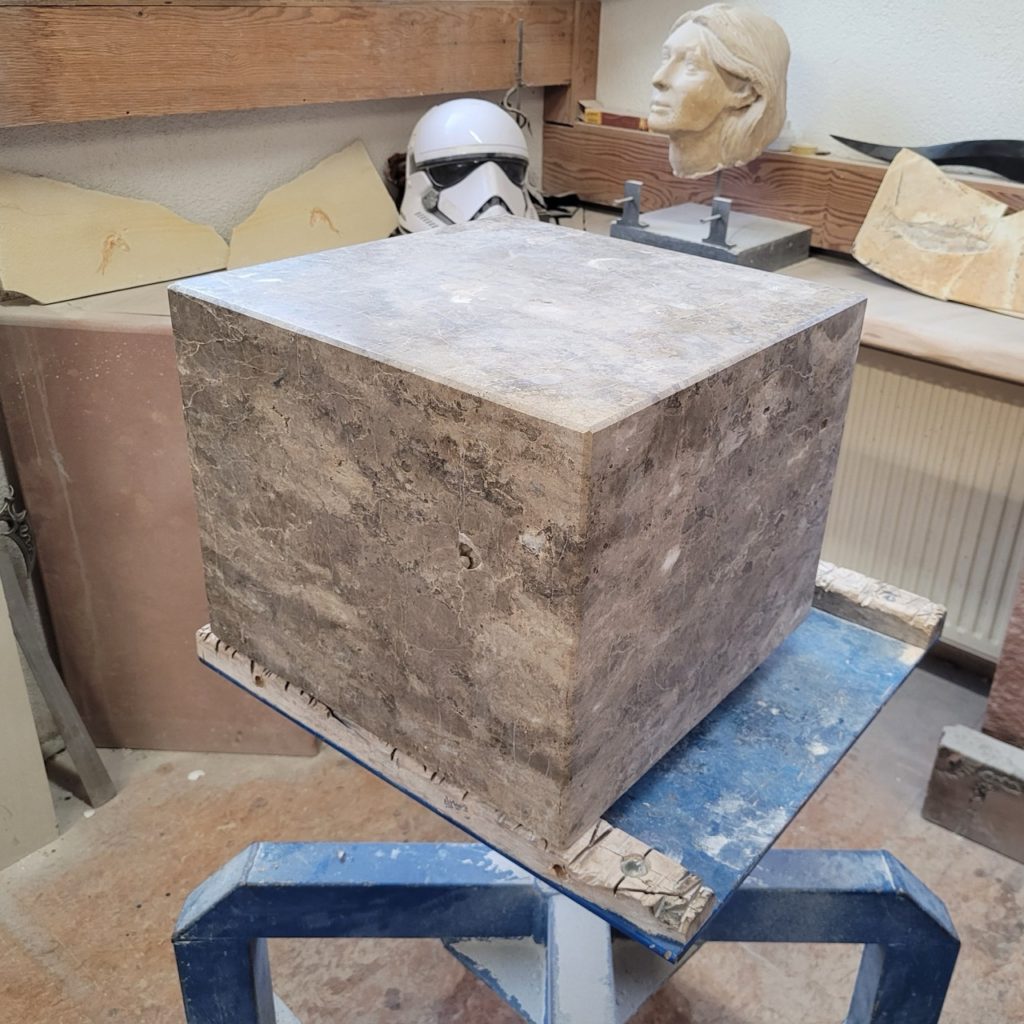
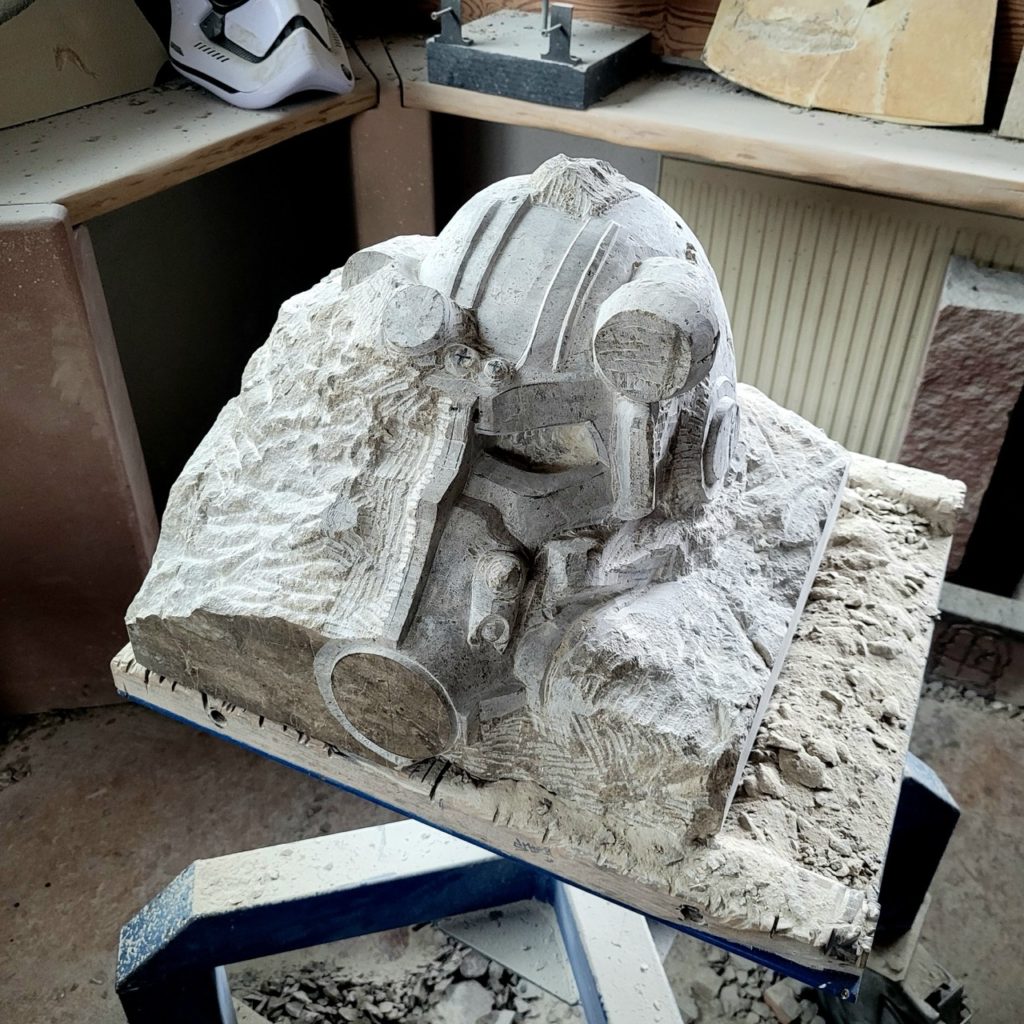
No sooner said than done. Sebastian, a close friend of mine, was immediately enthusiastic about my project and supported me with a 3D printed model. That makes it a bit easier than just working from photos and drawings.
This was the start of a great time with exciting and challenging work in the early hours of the morning. The alarm clock rang at 4 a.m., and I staggered sleepily into the workshop right next to our house. My faithful companion Fen, our black Labrador dog, accompanied me every morning without a murmur and helped to keep me motivated.
I used a brown-beige dolomite called "Limes dolomite" as the material. An interesting stone full of veins and crystals. This choice of material was intended to give the T-60 helmet the appearance of 200 years of weathering in the inhospitable wasteland.
Although this material appears fragile and cracked, it is very tough and allows even fine details without crumbling. Its hardness is comparable to a very fine-grained marble such as Palissandro Classico, but the color and structure is more similar to a typical limestone.
I took a photo of the stone with my permanently installed stop-motion camera every few strokes with the pointing iron. The resulting video provides a unique insight into the creation process.
At the end of each working day, I took a photo and published it on my Instagram profile as a daily story. This particularly appealed to the younger generation. The feedback was fantastic. As a volunteer apprentice supervisor in the Freiburg Stonemasons guild, it is important to me to present our profession in a modern and popular way and thus encourage one or two young people to train in our incredibly varied profession. I am currently training an apprentice myself.
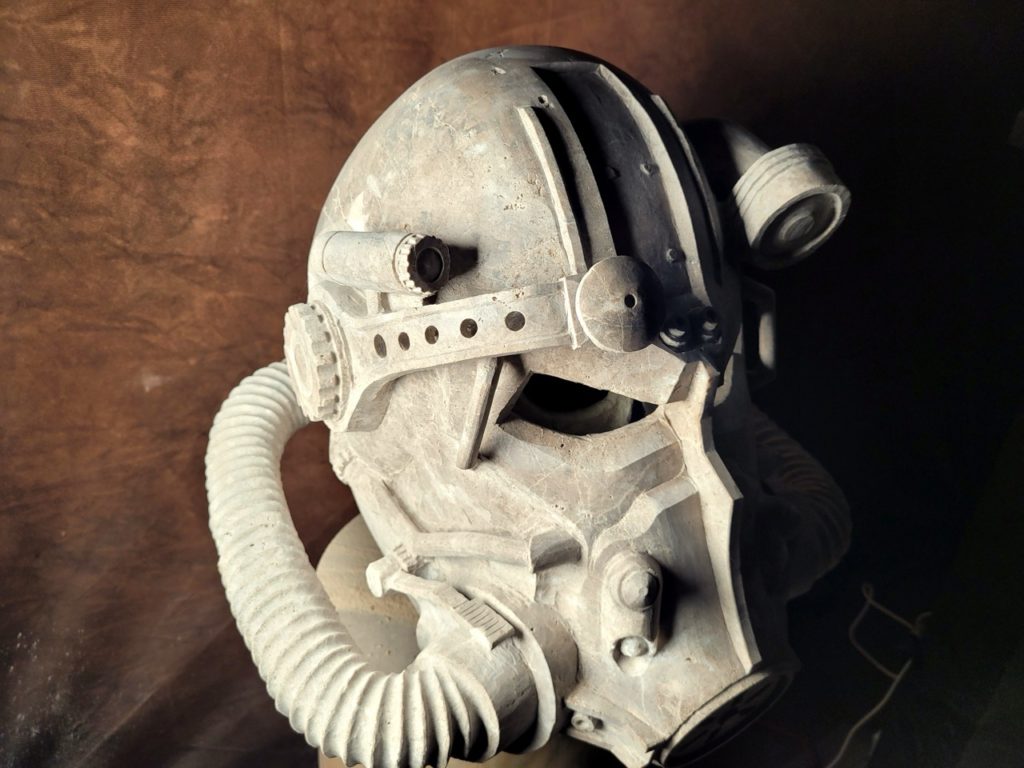
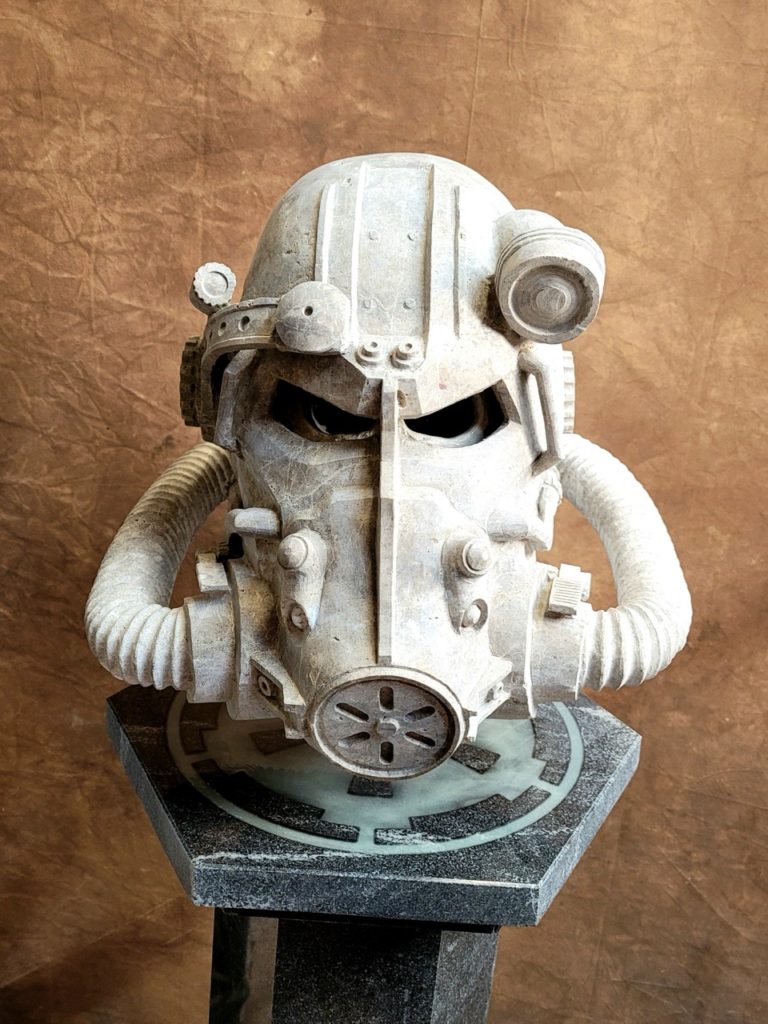
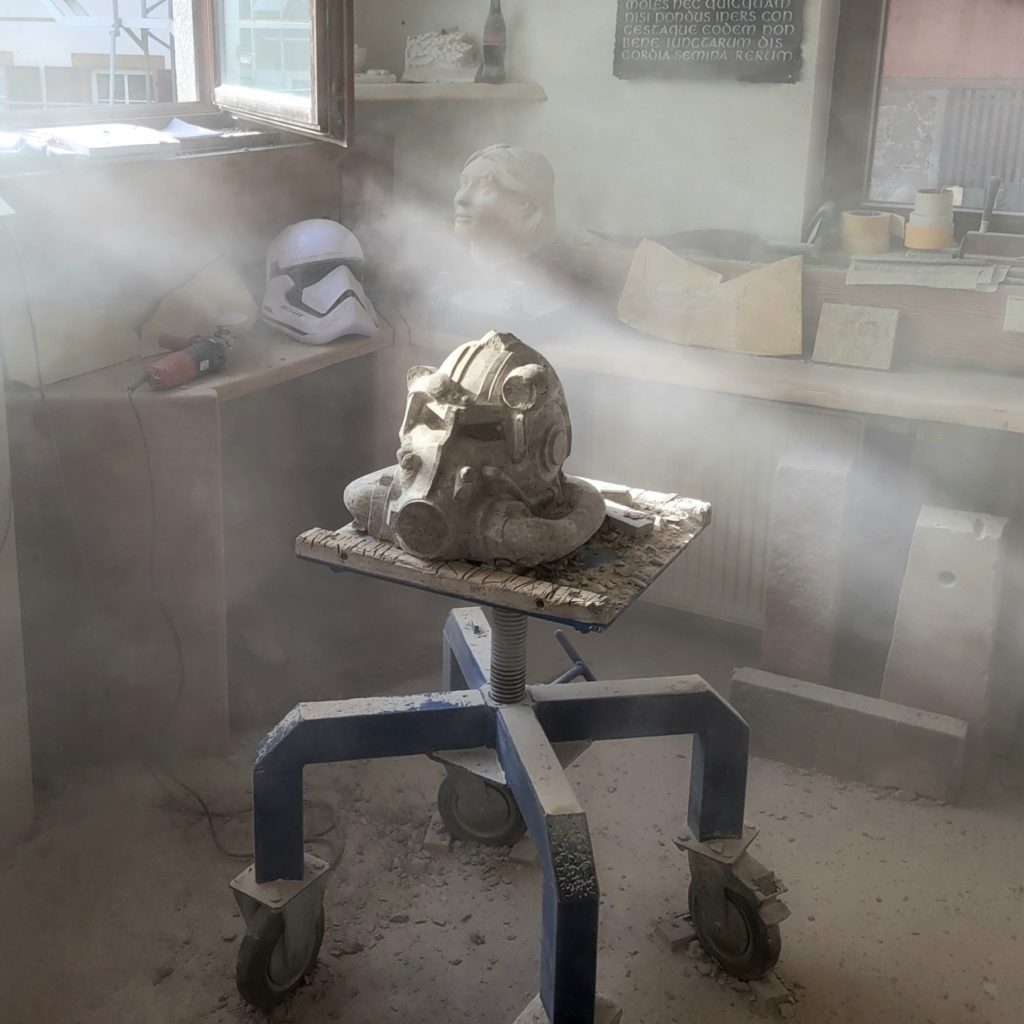
After many days, the shape of the helmet became clearer and clearer, piece by piece. The initial rough work with the pneumatic hammer and the Widia-tipped chisel and toothed iron progressed quickly and well. The progress was also followed with interest in social media, on numerous fan pages and various country profiles of the Fallout software developer Bethesda, which in turn continued to be posted.
Unfortunately, as the weeks went by and more and more details were added, my personal motivation dropped a little. I had the feeling that I was hardly making any progress. The coarse tools gave way to finer chisels, and the millimeter-by-millimeter battle for the right proportions and small details dragged on like chewing gum. Such inconspicuous little things as working out the screws in the lower area between the visor and the gas mask filter took almost a full day.
But after the first well-done finished details, the motivation returned.
The two brackets at the side of the eye openings were particularly challenging. For these pieces, I removed the stone to such an extent that these brackets were only a few millimeters thick and remained completely free-standing. After they were finished without any damage, I was really proud of them and this gave me new motivation.
A lot of the fine work could now only be accomplished with a small 3mm shank pneumatic milling cutter, the kind you might only know from the dentist. This makes the details look particularly clean and finely finished. The last step for the time being was the fine sanding of the whole helmet with 320 grit sandpaper, unfortunately mostly without a machine, by hand due to the lack of larger areas where the machine would have made sense.
When the helmet was finally finished, I thought to myself that there must be a hidden secret somewhere. My idea was to breathe a little history of the Fallout universe into the helmet.
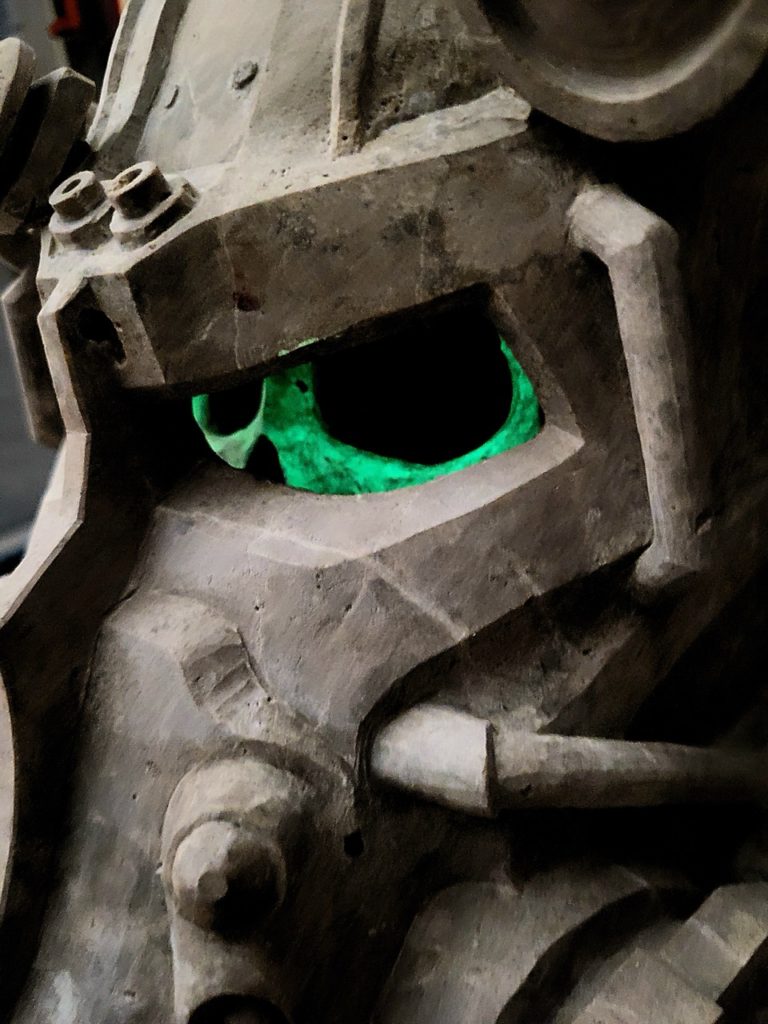
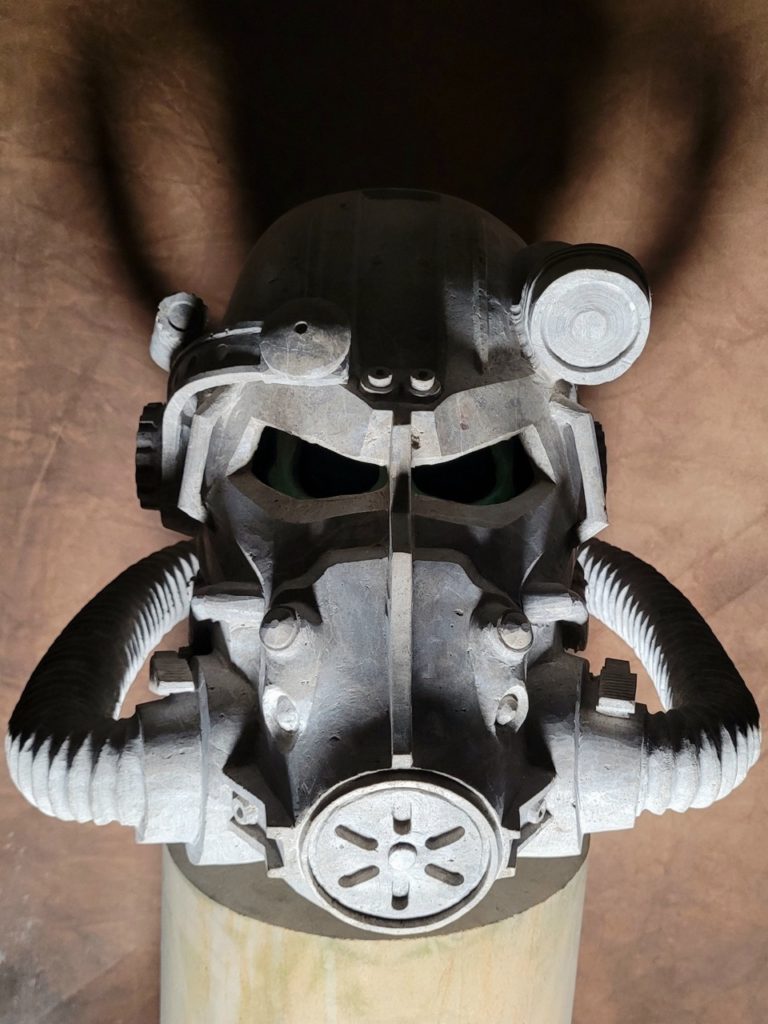
"Shortly before the great war in 2077, the government equipped the military with the new generation T-60 Power Armor. Despite the high protection of the armor, no one survived the mission while the bombs were falling."
What would someone who stumbled across a functional Power Armor over 200 years later find? Presumably, the irradiated remains of the previous owner.
So I started an Instagram poll to find out what people think of me working out a skull behind the visor. This poll was important to me because you often tend to get carried away when you don't have the necessary distance from the situation. The survey showed that 94% were enthusiastic.
So the very next morning I set to work full of enthusiasm. The realization went much faster than expected, after just a few hours it looked as if there was a skull hidden in the helmet. And one that glows faintly in the dark thanks to the luminescent paint.
And so the work has actually come to an end after around 25 early morning assignments. On the one hand, it's a relief to have brought everything to a successful conclusion, but there's also a strange emptiness that comes with suddenly having nothing more to do on the project that has filled your thoughts day after day. But for now, I'm happy to get some sleep again.
But the next project is already waiting in the wings, but that will be a different story.